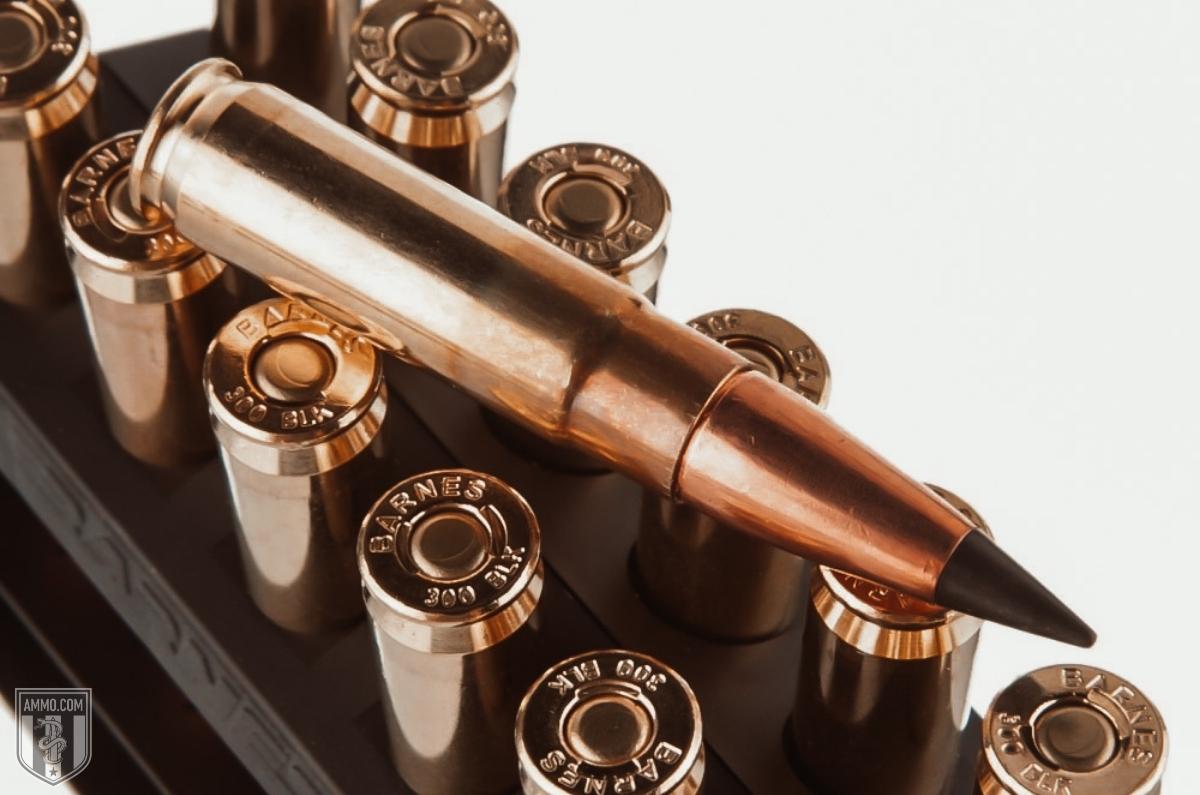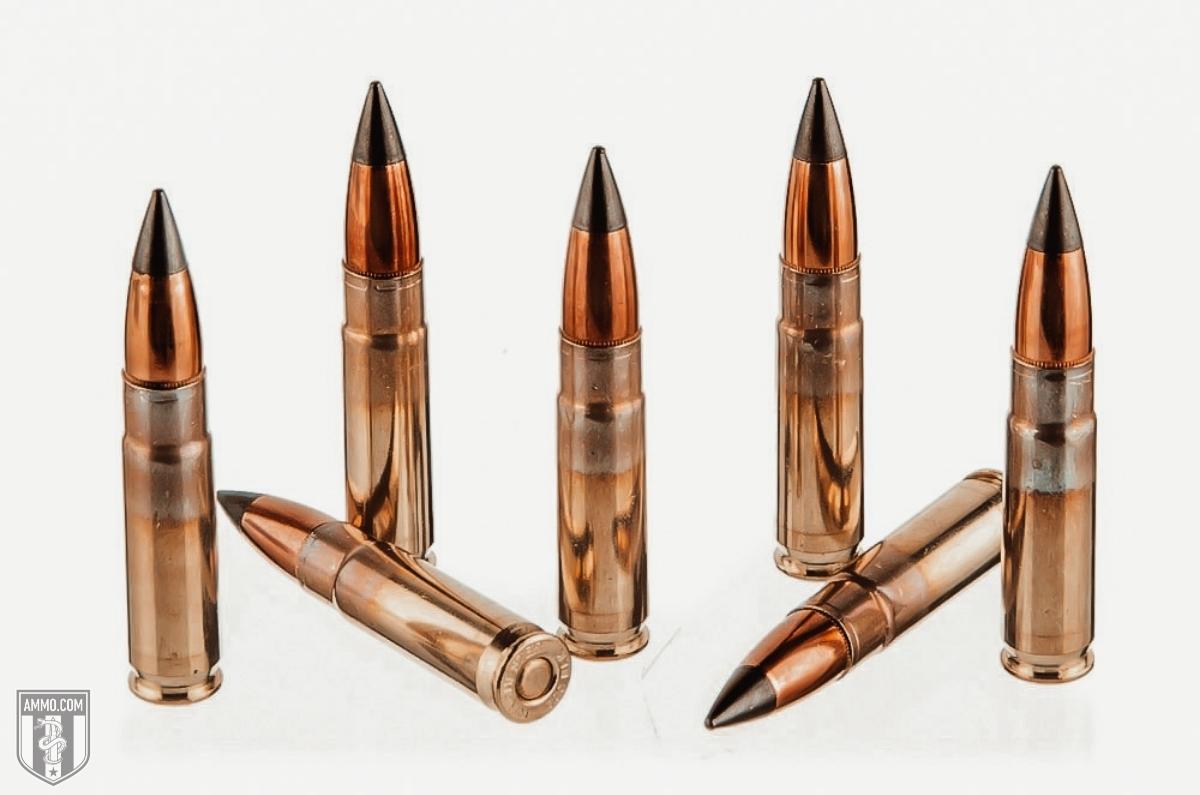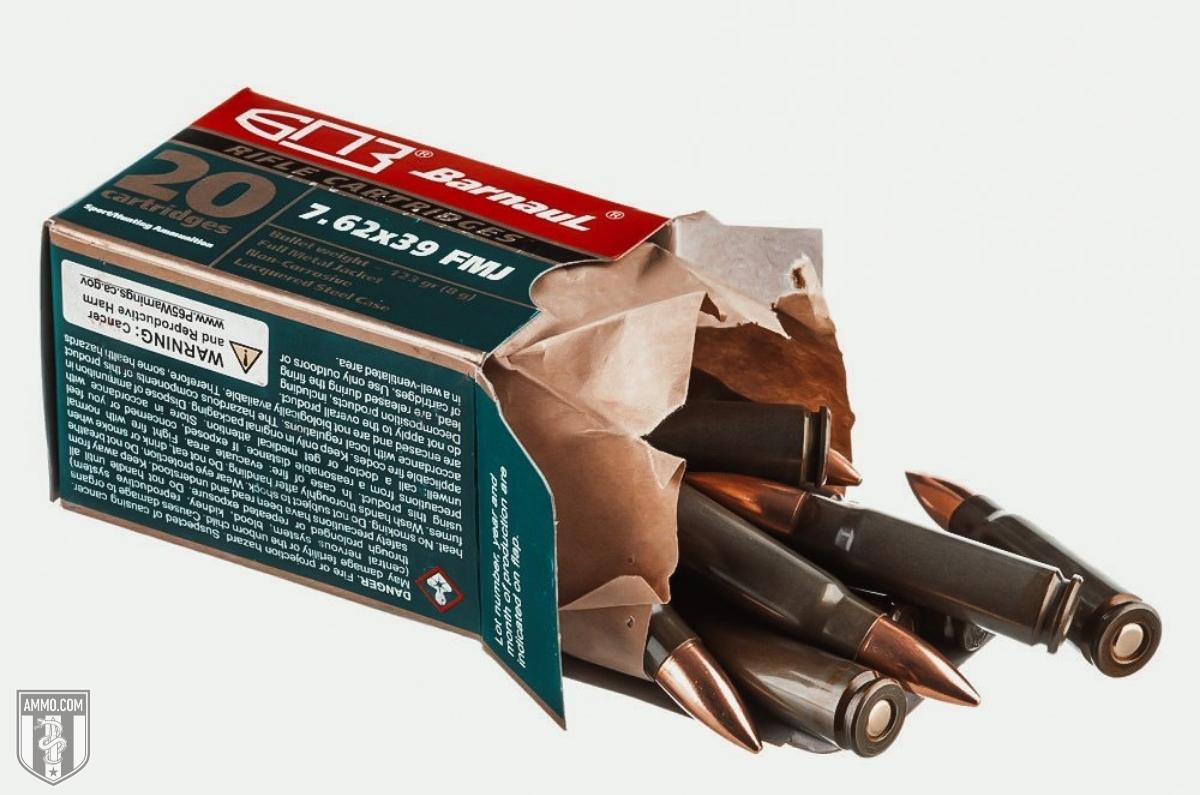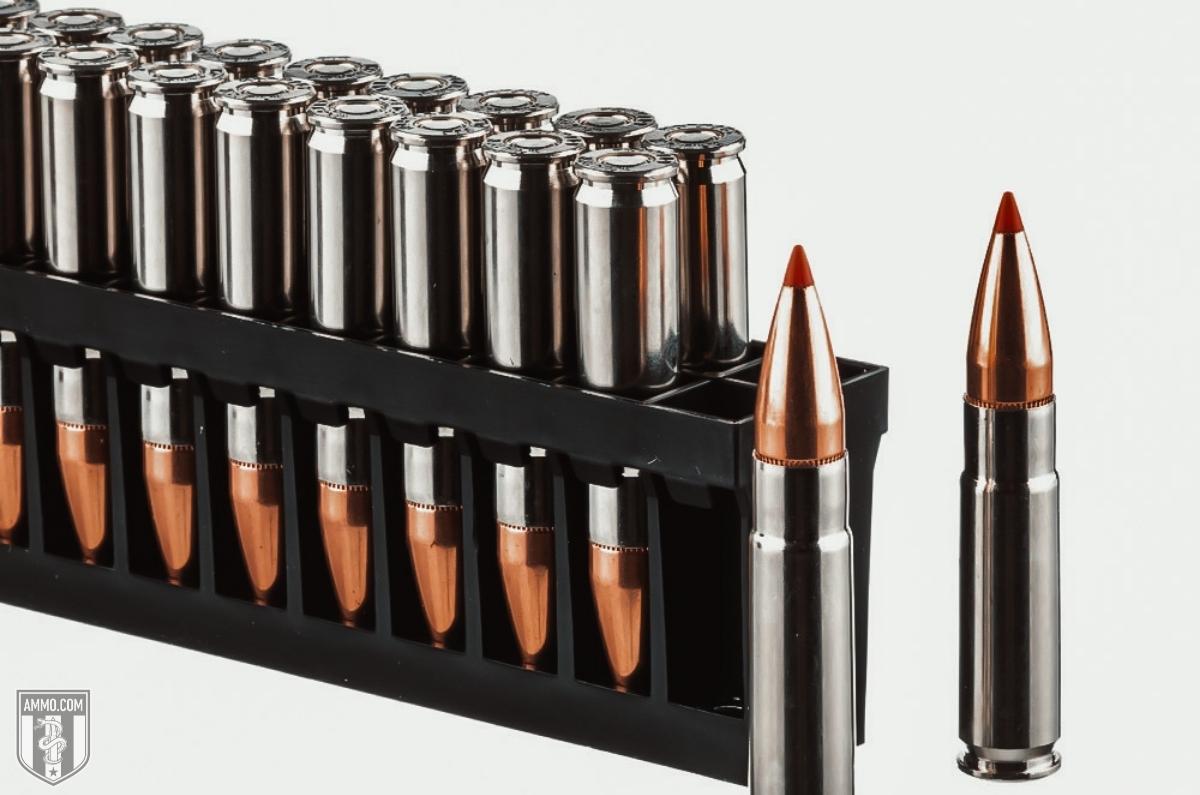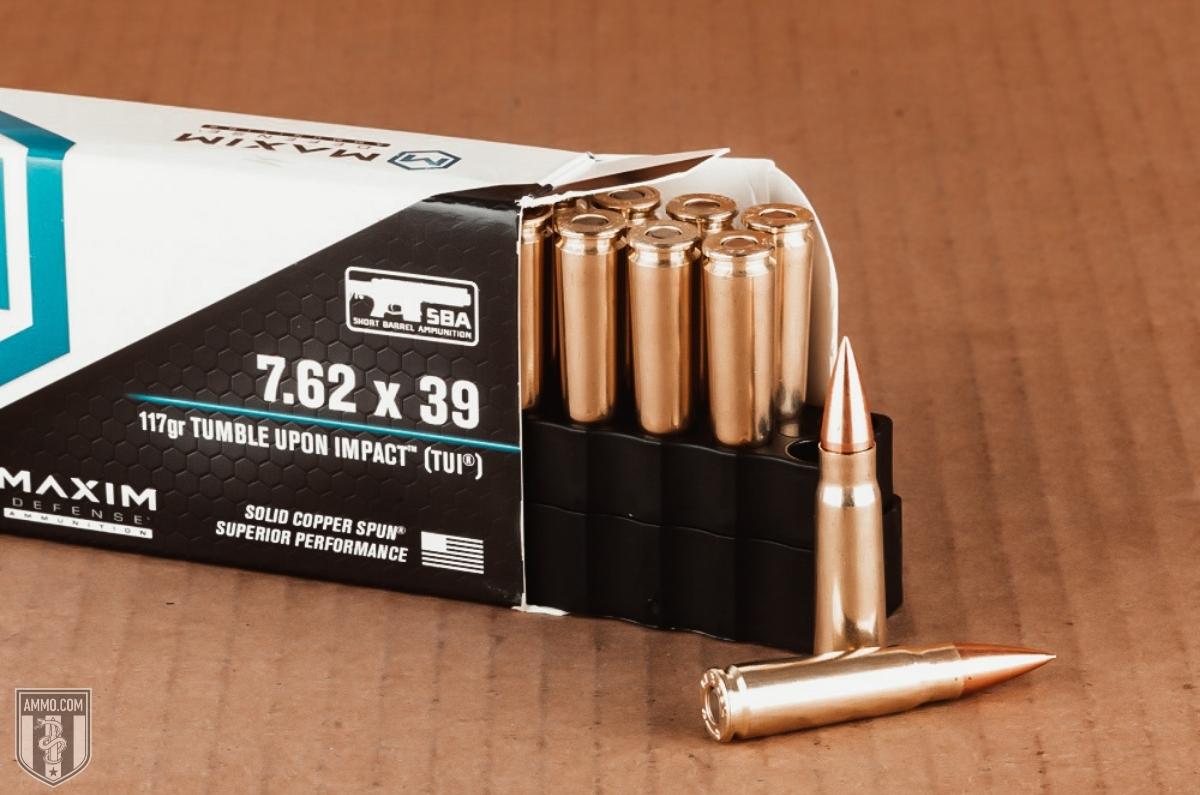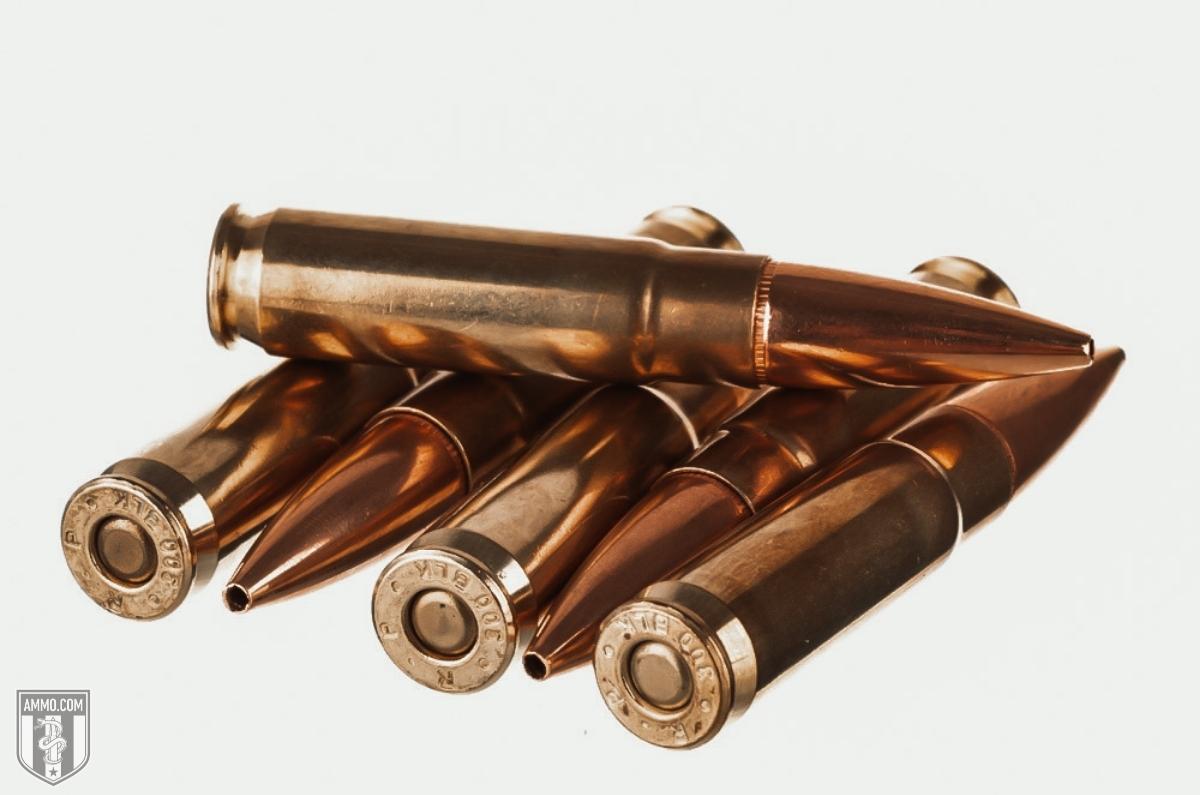7.62x39 vs 300 Blackout: Intermediate 30-Calibers Collide
 The 300 AAC Blackout and 7.62x39mm Soviet are two centerfire rifle cartridges that are extremely similar in terms of external ballistics and terminal performance.
The 300 AAC Blackout and 7.62x39mm Soviet are two centerfire rifle cartridges that are extremely similar in terms of external ballistics and terminal performance.
The 7.62x39 has been a mainstay for former Communist Bloc countries for decades and has proven its combat effectiveness on the battlefield time and time again. However, integrating the 7.62x39 into the American AR platform has been fraught with difficulties as the cartridge design does not function well with AR-15 magazine design.
Despite these difficulties, shooters yearned for an intermediate 30-caliber cartridge in their AR-15’s that could bridge the gap between the 5.56 NATO and 308 Winchester.
300 Blackout ammo is that bridge. There’s no denying that the 300 Blackout closely mimics the 7.62x39, but there are differences between these two cartridges that makes some shooters question which cartridge is right for their next sporting rifle.
In this article, we will compare and contrast the 300 BLK vs 7.62x39 to help you understand the subtle nuances that make each cartridge unique and perfect for your next rifle.
What is the Difference Between 7.62 x39 and 300 Blackout?
The ballistic performance of 7.62x39 and 300 Blackout is almost identical. However, the difference between 7.62x39 and 300 Blackout ammo is that the 7.62x39 was developed during WWII for use in the SKS and AK-47, while 300 Blackout was developed in 2010 for use in a short barreled and suppressed M4 carbine. Furthermore, the 300 Blackout can fire supersonic and subsonic loads while most 7.62x39 ammo will be loaded for supersonic flight.
Is 7.62 x39 the Same as 300 Blackout?
No! The two cartridges are completely different and are not interchangeable.
You should never fire a round that your rifle is not chambered for, as doing so can cause a catastrophic failure that could damage your firearm and yourself.
Furthermore, although both rifle cartridges are labeled as 30-caliber, the 7.62x39 fires a 0.311” diameter bullet while 300 Blackout fires a .308” diameter bullet.
Cartridge Specs
When comparing two rifle cartridges, it’s a good idea to analyze the cartridge specs to gain more knowledge of each.
One major difference between 7.62x39 and 300 Blackout is their case length, with the 7.62 being the longer of the two. This in turn affects the case capacity of both rounds, with the 7.62 having a higher case capacity of 35.6 gr H2O vs 26.5 gr H20 for 300 BLK.
Many would think that with almost 25% higher case capacity, the 7.62x39 will have a significantly higher muzzle velocity, but that’s not actually the case. For 300 BLK supersonic loads using a 125 grain bullet there is only about a 100 fps difference between it and 7.62.
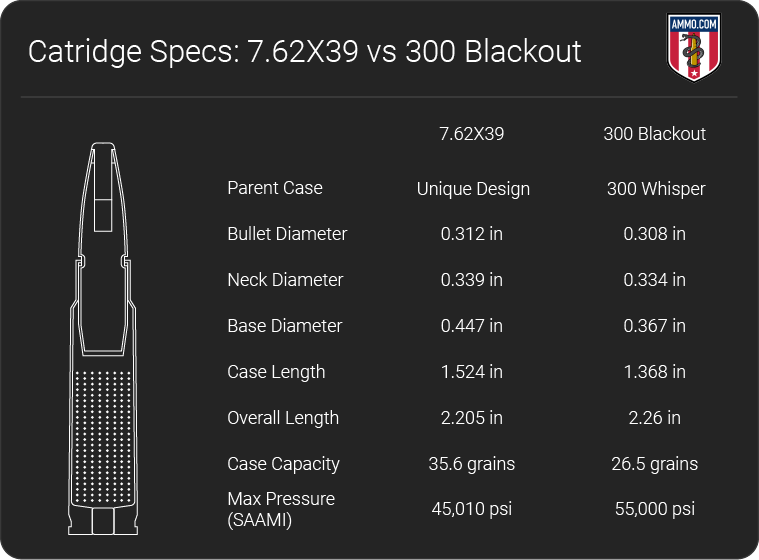
This is a true testament to the advancements in gunpowder technology since the development of the 7.62x39. However, using those advanced propellants comes at the cost of added pressure.
This is why the 300 BLK is rated for 55,000 psi vs 45,010 psi for 7.62x39 based on SAAMI specs.
Why Does 7.62x39 and 300 AAC Blackout Fire Different Bullet Diameters?
One interesting thing to note is that the 7.62x39 is not a true 30-caliber bullet based on the US standards of caliber measurement. The 300 BLK fires a 0.308” diameter bullet just like the 308 Winchester (7.62x51mm NATO), 30-06 Springfield, and 300 Win Mag. However, the 7.62x39 fires a 0.311” diameter bullet.
But why then is the Russian ammo designated a 7.62mm caliber? This is due to a discrepancy between how Russian and American gunsmiths measure bullet caliber.
In the photo to the right, you’ll see an artistic depiction of barrel rifling. The high points are called “lands” while the low points are called “grooves”.
Western gunsmiths use groove measurements to define the caliber of a bullet (which will be larger than land measurements). Even though the land measurement will be 7.62mm or 0.3” the actual bullet diameter will be 0.308” or 7.82mm because a bullet must contact the grooves of the barrel to for a tight seal.
To make things more confusing, Russian gunsmiths use land measurements to define bullet diameter. This means that the land measurement on an AK-47 or SKS, and therefore the true bullet diameter, will measure 0.311” or 7.90mm.
Recoil
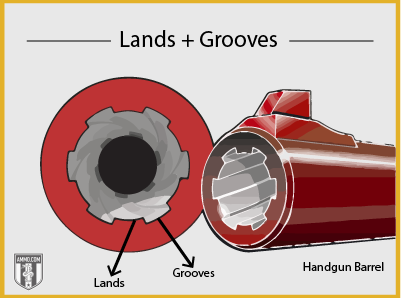
Both the 300 Blackout and 7.62x39mm are well known for having mild recoil. Most shooters will not have a problem shooting either of them all day at the range.
As the 300 BLK has lower case capacity, it will generally have less recoil than the Russian 7.62x39.
On average over several supersonic loadings, the 300 Blackout will have 6 ft-lbs of felt recoil while the 7.62 will have 8.5 foot-pounds of recoil energy on average.
Most shooters will not have any issue handling the recoil from either rifle cartridge, as both are very mild, but for recoil sensitive marksmen the 300 BLK will be the better choice.
Trajectory
Trajectory is how we quantify a bullet’s flight path as it travels downrange measured in inches of bullet drop.
Obviously, a flatter shooting cartridge is preferred for shooting longer ranges, as a shooter will require fewer adjustments to their optics to compensate for bullet drop. Having a flatter trajectory also means that a cartridge will be more forgiving of ranging mistakes.
Neither the 7.62 Soviet nor 300 Blackout round is known for having an extremely flat trajectory. However, the 7.62x39 will have the better trajectory of the two.
At 400 yards, the 123 grain 7.62x39 will have experienced about -44” of bullet drop while the 125 grain 300 BLK will have dropped approximately -68”.
This trajectory of both 30-caliber intermediate cartridges limits their effective range to around 400 yards, which is exactly what they are designed for.
Subsonic 300 Blackout ammo makes the 7.62x39 look like it has the trajectory of a 308 Winchester!
At only 300 yards, 220 grain 300 BLK rounds have experienced around -100” of bullet drop. Again, this trajectory is not surprising, as subsonic loads are designed for close quarters combat, not long range shooting.
Ballistic Coefficient
Ballistic coefficient (BC) is a measure of how well a bullet resists wind drift and air resistance. Put another way, it’s a numeric representation of how aerodynamic a bullet is. A high BC is preferred as this means the bullet will buck the wind easier.
Generally, heavy bullets will have a higher BC as it takes more force to disrupt the flight of a heavier bullet than a lighter one. Ballistic coefficient varies from bullet to bullet based on design, weight, and other factors that are beyond the scope of this article.
The 7.62x39 has an average BC of 0.27. Some of the heavier subsonic bullets for 300 Blackout have extremely high BC, such as the 208 gr Hornady 300 Blackout ammo (A-Max), at 0.648. However, 300 BLK ammo has a BC around 0.35 in general.
Although the two rounds have similar bullet weights (123 vs 125 gr), the 300 BLK is typically loaded with modern bullets that are more aerodynamic than the older design 7.62x39 projectiles.
Sectional Density
Sectional Density (SD) is the measure of how well a bullet penetrates a target. This is extremely important when hunting big and medium sized game, as you need a bullet that can punch through thick hide, bone, and sinew.
Sectional density is calculated by comparing the bullet weight and the bullet diameter. The higher the SD the deeper the bullet will penetrate into the target. This is a simplified view of penetration as there are other factors to consider, such as bullet expansion and velocity.
Bullet jacket design also plays a part in penetration, as a bullet designed to expand like a soft point (SP), ballistic tip, or jacketed hollow point (JHP) will naturally penetrate less than a full metal jacket (FMJ).
Average SD for 300 BLK comes out to 0.21 while the 7.62x39 measures at 0.18. These values are virtually the same and it is unlikely that any hunter or game animal will be able to tell the difference in penetration between the two rounds.
Hunting
Although neither round was designed with hunting in mind, hunters have found that both the 300 Blackout and 7.62x39 to be extremely effective on medium sized game at short range.
It is generally accepted that it takes 1,000 ft-lbs of energy to ethically harvest a whitetail deer. According to the Ballistics Tables below, this means that both rounds are effective against deer and ranges slightly below 200 yards.
Feral hog hunters enjoy the capabilities of the AR-15 platform and AK variants for engaging large herds of hogs that can decimate an entire field overnight. The semi-automatic capability of both rifles lends itself to quick follow-up shots that are extremely useful when trying to dispatch multiple hogs before the herd scatters.
A quick note on subsonic ammunition and hunting – it is NOT recommended to use subsonic loads for hunting medium game. The subsonic rounds simply do not have the terminal ballistics at hunting ranges to be effective and ethical at harvesting game. Therefore, make sure you are using supersonic .300 Blackout ammo when hunting.
Don't forget to stock up on your ammo. Visit our Fiocchi 300 Blackout ammo page for more affordable options.
Home Defense
There’s no denying that the 7.62x39 Soviet is an extremely effective cartridge at both short and medium engagement distances. However, when it comes to home defense, the subsonic 300 Blackout cartridge is the superior choice for one reason:
Over Penetration
The 7.62 round is well known for its ability to penetrate barriers, and though this might be beneficial in wartime, it is a huge liability when it comes to home defense.
The last thing anyone wants in a self-defense situation is to injure an innocent bystander. As you are responsible for every bullet you fire, you do not want them ending up anywhere other than inside the bad guy.
In a home defense situation, it is very likely that you’ll have neighbors nearby unless you live in the country. As such, the 7.62’s ability to plow through barriers increases the risk of injuring an innocent bystander.
Since the subsonic loads were designed for close quarters battle (CQB) and to not over penetrate, this makes them the ideal choice for hone defense.
Combined with a suppressor, these rounds are completely hearing safe (no ear protection needed), which is a huge boon as shots fired inside a residence are usually louder since the sound echoes off the walls.
An AR pistol or rifle with a suppressor and a full mag of subsonic 300 Blackout ammo will be more than enough to handle any home defense situation.
The 7.62x39 is an extremely capable cartridge and will not have any problem repelling any would-be home invader, however the potential for over penetration with 7.62 makes subsonic 300 BLK ammo a better option.
Ammo and Rifle Cost/Availability
If you like to shoot a lot and not break the bank, then the 7.62x39 is the ultimate plinking centerfire round. As there is an ample supply of European produced steel cased ammo on the market, the 7.62x39 is incredibly affordable to shoot.
When purchasing bulk FMJ ammo, it’s not hard to find 7.62x39 for about $0.36/round. However, premium hunting ammo from manufacturers like Nosler, Federal, Hornady and Remington will typically retail for around $1.50/round and up.
On the other hand, 300 AAC Blackout is a bit more expensive with cheap FMJ ammo typically running close to $1/round. Premium hunting and self-defense ammo typically retails for around $1.5-2/round and up for 300 BLK.
Buying in bulk is always smart, make sure to check out our stock of bulk 300 blackout ammo and bulk 7.62x39 ammo.
In terms of rifle availability, both cartridge have plenty of semi-automatic options available. For the 7.62x39 you’ll be looking for at AK variants and surplus SKS rifles that are fairly easy to find on gun store shelves or on the secondary market. If you’re not into surplus AK rifles, there are plenty of new production rifles available from manufacturers like Arsenal, Krebs Custom, IWI, and Palmetto State Armory.
However, not every firearm connoisseur want’s an AK variant. Luckly for those with discerning taste in their rifles, there are several options available. Ruger took their Mini-14 (originally chambered in 223 Rem) and created the Mini-30 which is chambered in 7.62x39. If you want an AR pattern rifle in 7.62x39 there are fewer options as the sever case angle makes feeding unreliable in an AR rifle. However, the CMMG Mutant and the PSAK-47 are two of the best options available (but they are pricey).
For 300 Blackout ammo, any AR-15 rifle can be easily converted to fire 300 Blackout with a barrel change. As the 300 BLK uses the same magazines and bolt as the 223 Rem/5.56 NATO, this makes a 300 Blackout conversion ridiculously simple.
Most all AR-15 manufacturers have conceded that the 300 BLK is here to stay and there are plenty factory produced 300 BLK rifles available if you don’t want to do a conversion. If you’re not into the AR platform, then Ruger has released their Mini-14 Tactical chambered in 300 Blackout.
For hunters, there are several bolt action rifles available for both calibers.
As the 7.62x39 has only recently been accepted as a hunting cartridge, the CZ 527 and Ruger American Ranch are the two best options for the caliber. Both rifles are also chambered in 300 Blackout, but manufactures like Savage, Remington, and Howa also have 300 BLK options.
Reloading
If you’re into handloading, then you’re going to love the 300 Blackout. As it fires the same caliber bullet and uses similar powders as the 308 Winchester, 30-06 Springfield, and 300 Win Mag (just to name a few) it makes finding components very simple. Brass is relatively easy to acquire, but if you know what you’re doing, you can make your own 300 BLK brass out of 223 Rem cases.
Reloading allows you to customize your 300 Blackout ammo to your specifications and reduces your overall cost per round.
However, this is not necessarily true for 7.62x39. Since steel cased ammo is so inexpensive, it is often not cost-effective to reload for 7.62x39. To complicate things, 0.311” diameter bullets are not as common as 0.308”, making it more difficult to find components. Brass cases are also difficult to come by for 7.62x39 as most ammo manufactures use steel cases, which cannot be reloaded.
If you plan on handloading your own ammo, the 300 Blackout is clearly the superior option.
Ballistics: 7.62 x39 vs 300 Blackout
Our team here at Ammo.com has spent countless hours scouring the Internet to bring you extremely comprehensive ballistics tables for both calibers. Below are tables that compare bullet weight to muzzle velocity, kinetic energy, and trajectory for both 300 Blackout vs 7.62x39.
7.62x39 Ballistics Chart
Note: This information comes from the manufacturer and is for informational purposes only. The actual ballistics obtained with your firearm can vary considerably from the advertised ballistics. Also, ballistics can vary from lot to lot with the same brand and type load.
| 7.62x39 Bullet WEIGHT | Muzzle VELOCITY (fps) | Muzzle ENERGY (ft. lbs.) | TRAJECTORY (in.) | |||||||||||
|---|---|---|---|---|---|---|---|---|---|---|---|---|---|---|
| Muzzle | 100 yds. | 200 yds. | 300 yds. | 400 yds. | Muzzle | 100 yds. | 200 yds. | 300 yds. | 400 yds. | 100 yds. | 200 yds. | 300 yds. | 400 yds. | |
| 123 Grain | 2360 | 2049 | 1764 | 1511 | 1296 | 1521 | 1147 | 850 | 623 | 459 | 3.4 | 0 | -14.7 | -44.7 |
| 123 Grain | 2300 | 2030 | 1780 | 1550 | 1350 | 1445 | 1125 | 860 | 655 | 500 | 2.5 | -2 | -17.5 | 0 |
| 125 Grain | 2300 | 2030 | 1780 | 1550 | 1350 | 1445 | 1125 | 860 | 655 | 500 | 2.5 | -2 | -17.5 | 0 |
.300 Blackout Ballistics
Note: This information comes from the manufacturer and is for informational purposes only. The actual ballistics obtained with your firearm can vary considerably from the advertised ballistics. Also, ballistics can vary from lot to lot with the same brand and type load.
| 300 Blackout Bullet WEIGHT | Muzzle VELOCITY (fps) | Muzzle ENERGY (ft. lbs.) | TRAJECTORY (in.) | |||||||||||
|---|---|---|---|---|---|---|---|---|---|---|---|---|---|---|
| Muzzle | 100 yds. | 200 yds. | 300 yds. | 400 yds. | Muzzle | 100 yds. | 200 yds. | 300 yds. | 400 yds. | 100 yds. | 200 yds. | 300 yds. | 400 yds. | |
| 110 Grain | 2150 | 1886 | 1646 | 1432 | 1254 | 1128 | 869 | 661 | 501 | 384 | 0 | -8.3 | -29.6 | -67.8 |
| 125 Grain | 2250 | 2031 | 1826 | 1636 | 1464 | 1404 | 1145 | 926 | 743 | 595 | 0 | -7 | -24.4 | -54.8 |
| 220 Grain | 1000 | 968 | n/a | n/a | n/a | 488 | 457 | n/a | n/a | n/a | 0 | n/a | n/a | n/a |
A Brief History of 300 Blackout
The development of the 300 AAC Blackout (designated 300 BLK by SAAMI) rifle cartridge began in 2010 when Robert Silvers of the Advanced Armament Corporation (which was later acquired by Remington) was approached by a member of the US Military “dark ops” community.
Some special forces units were unhappy with the stopping power that the 5.56 NATO and the 9mm (used in several SMGs) offered during close quarters combat and he wanted something that had more “oomph”. Something along the lines of the 7.62x39mm.
However, there were some other requirements that this customer required as well:
- The rounds needed to fit into STANAG standard AR-pattern mags and maintain their 30-round capacity
- The cartridge case head must be the same as 5.56mm NATO so a bolt change was not needed
- It had to shoot 30 caliber projectiles and mimic the terminal performance of the 7.62x39
- The new rifle cartridge needed to be compatible with short barrel rifles (SBR, barrels under 16”) and be completely functional with a suppressor/silencer
- Supersonic and subsonic ammo needed to be available and functional
Integrating new calibers into the AR-15 platform is nothing new to the shooting community. The 6.8 Remington Special Purpose Cartridge (SPC) and 6.5 Grendel are two examples that were mildly successful; however, they both required a new bolt and did not maintain the 30-round capacity requirement.
Simply modifying a M4 to fire 7.62x39mm was not an option either as the severe case angle causes multiple chambering issues using standard M4 mags. This is why you see such extreme curvature in AK mags.
A new cartridge had to be developed and the 300 Whisper, pioneered by JD Jones, was selected as the parent case. Since the 300 Whisper was a wildcat cartridge, and therefore could not simply be adopted for military use as it was not SAAMI standardized.
The new round was called 300 AAC Blackout ammo (300 BLK or 300 Blackout) and was approved by SAAMI on January 17, 2011.
300 BLK ammo can be broken down into two different bullet weights, 220 grain subsonic and 110 to 125 grain supersonic.
Supersonic ammo, typically firing a 125 grain bullet, will have a muzzle velocity of approximately 2250 fps and have a muzzle energy of around 1404 ft-lbs. Industry standards list the effective range of the supersonic 125 grain bullet loadings to be 500 yards.
In contrast, subsonic loads will fire a 220 grain bullet and have a muzzle velocity of around 1000 fps and a muzzle energy of 488 ft-lbs with an effective range of 200 yards.
These two popular loadings really illustrate the versatility of 300 Blackout ammo. With a simple magazine change, a shooter can switch from supersonic ammunition and long-range engagements to subsonic ammunition for short range combat.
Furthermore, the 300 BLK was designed specifically to experience a full powder burn when being fired in a 9” short barrel rifle (SBR), preferably with a suppressor/silencer.
If you’d like to learn more about how the 300 BLK compares to other calibers, check out 300 Blackout vs 5.56 NATO and 300 Blackout vs 308 Winchester!
A Brief History of 7.62x39
In the later stages of World War II, the Nazi regime introduced a rifle that changed the way soldiers have waged ever since.
The Sturmgewehr 44, or StG-44 for short, was a magazine fed assault rifle capable of automatic fire utilizing lighter weight bullets. The use of an intermediate cartridge allowed the StG-44 to be controllable during automatic fire, was more compact than the standard battle rifles of the time, and were designed to hit targets several hundred yards away.
This flew in the face of the established battle rifles of World War II, namely the Russian bolt action Mosin Nagant and American semi-auto M1 Garand, that could hit targets well over 500 yards away even though most battles occurred at closer ranges. Both rifles were extremely effective, however they weighed a ton, were difficult to maneuver at close range, and had heavy recoil making automatic fire difficult to control.
Seeing the effectiveness of the StG-44, the Soviet Union decided that they wanted to develop an intermediate cartridge for their new battle rifle. They wanted this rifle cartridge to be suitable for a host of firearms, from a semi-auto carbine for close range to fully automatic machine guns for suppressive fire.
Hundreds of unique cartridge designs were submitted but eventually the Soviets settled on 57-N-231, which had cartridge dimensions of 7.62x41mm.
The bullet that was used did not have a boat tail, as the Soviet cartridge designers assumed (incorrectly) that a boat tail was only needed for long range shots. The assumption that all combat would be at close range led them to this decision as they did not expect shots to be taken at longer distance.
However, after extensive testing, the Soviets determined that the boat tail increased close range accuracy as well and a new bullet with a boat tail was adopted. This longer bullet required the cartridge case to be shortened to 39mm and the ubiquitous 7.62x39 was born.
Given the military designation M43, the 7.62x39 was adopted for the semi-automatic SKS in 1945 and Mikhail Kalashnikov’s famous assault rifle, the AK-47 in 1949. The Ak-47 became the most mass-produced military rifle in existence and the 7.62x39 has shared in its success. The RPD and RPK machine guns were also chambered in 7.62x39mm.
The Russians designed 7.62x39 ammo to fire a 123 grain weight FMJ bullet with a muzzle velocity of 2,350 fps, 1,600 ft-lbs of muzzle energy, and a combat effective range of 400 yards. Typical bullet weights for 7.62 ranges between 120 to 125 grains, with 123 loadings being the most prevalent.
With the popularity of the 7.62x39 on the rise, soft point (SP) hunting ammo has become more readily available for hunting whitetail and other medium sized game animals.
The 7.62x39 has seen combat on 5 continents and is truly one of the most prevalent and combat-effective rounds to come out of the Cold War.
If you’d like to learn more about how the 7.62x39 compares to other calibers, check out 7.62x39 vs 308, 7.62x39 vs 5.56, and 7.62x39 vs 30-30!
Final Shots: 7.62 x39 vs 300 Blackout
There’s no doubt that the 7.62x39 and 300 AAC Blackout are two intermediate 30-caliber cartridges that will see use on the battlefield and in the woods for years to come. The terminal performance of a 30 caliber bullet has been well documented, and both rounds will deliver when it matters the most.
The 7.62x39 has been a force to be reckoned with since its introduction in the latter stages of World War II. In terms of ballistics, it is slightly superior to the 300 Blackout in terms of muzzle velocity, kinetic energy, and trajectory. Where the 7.62 falls short is in flexibility, as most factory loads fire 120-125 grain bullets, somewhat limiting the different applications of the 7.62x39.
300 AAC Blackout ammo is a round that truly revolutionized the AR platform, allowing shooters to fire a 30 caliber bullet from their AR-15 with merely a barrel change. The compatibility of a standard AR bolt and mags is a huge boon to the cartridge and allows shooters who are already invested in 5.56 NATO to fire a 7.62mm caliber bullet with minimal changes to their setup.
Which caliber is best for you revolves around what you want to do with your rifle.
If you’re looking for an inexpensive round to go plinking with, it’s hard to beat the 7.62x39 in terms of ammo cost basis. Surplus military ammo is still readily available and inexpensive, making for a fun day at the range without punching holes in your wallet.
On the other hand, if you’re looking for a cartridge that was designed for the AR-15 carbine and for use with a suppressor, 300 Blackout ammo is the round for you. Capable of firing supersonic and subsonic loads while maintaining reliability in AR barrels as low as 9” in length, the 300 Blackout is the ideal candidate for a suppressed SBR AR-15 rifle.
In terms of home defense, you cannot go wrong with either cartridge. However, the 300 BLK has a slight advantage due to the availability of subsonic factory self-defense loads that will not over penetrate as much as a 7.62x39.
In the end, the 7.62x39mm and 300 Blackout are more similar than they are different. They both have their strengths and weaknesses, but which one is best for you primarily centers around your preferred rifle system and needs as a shooter.
Regardless of which cartridge you choose, make sure that you get all of your ammo here at Ammo.com and fine tune your marksmen ship skills so that you’re ready in any situation.
Ammo Comparisons
- .308 vs 5.56
- 6.5 Creedmoor vs .308
- .300 Blackout vs .308
- .300 Win Mag vs .308
- .243 vs .308
- .308 vs .30-06
- 7mm-08 vs .308
- .270 vs .308
- 7.62x39 vs .308
- .223 vs .308
- .338 Lapua vs .308
- .380 ACP vs 9mm
- .223 vs 5.56
- .300 Blackout vs 5.56
- 9mm vs 45 ACP
- 9mm vs 40 S&W
- .357 SIG vs 9mm
- 10mm vs 9mm
- 9mm vs 9mm Luger
- .243 vs .270
- .300 Win Mag vs .30-06
- .270 vs .30-06
- .40 vs .45
- 38 Special vs 357
- 9mm vs 40 vs 45
- 5.56 vs 7.62x39
- 338 Lapua vs .30-06
- .30-30 vs .30-06
- 300 PRC vs 338 Lapua
- .30-06 vs 7mm
- 300 Win Mag vs 338 Lapua
- 300 PRC vs 300 Win Mag
- 300 WSM vs 300 Win Mag
- 338 Win Mag vs 338 Lapua
- 12 Gauge vs 20 Gauge
- 10mm vs 357 Mag
- .30-30 vs 7.62x39
- 224 Valkyrie vs 22-250
- 17 HMR vs 22 Mag
- 7.62x39 vs .300 Blackout
- 45 ACP vs 45 Auto
- 45-70 vs 30-30
- 300 Blackout vs 223
- 357 Magnum vs 9mm
- 350 Legend vs 300 Blackout
- 224 Valkyrie vs 223
- 45 ACP vs 38 Super
- 6.5 Grendel vs .308
- 17 HMR vs 22 LR
- 10 Gauge vs 12 Gauge
- 22-250 vs 223
- 45 Colt vs 45 ACP
- 350 Legend vs 30-30
- 5.7x28 vs 223
- 5.7 vs 9mm
- 5.56 vs 5.7
- 22 vs 9mm
- Buckshot vs Birdshot
- 450 Bushmaster vs 308
- 450 Bushmaster vs 223
- Buckshot vs Slug
- 6.5 Grendel vs 5.56 vs 223
- 6mm ARC vs 6.5 Grendel
- 44 vs 45
- 458 SOCOM vs 5.56
- 357 vs 44
- 32 ACP vs 380
- 300 Win Mag vs 338 Win Mag vs 338 Lapua Mag
- 450 Bushmaster vs 458 SOCOM vs 50 Beowulf
- 6mm Creedmoor vs 6.5 Creedmoor
- TMJ vs FMJ
- 44 Special Vs 44 Magnum
- 45 90 vs 45 70
- 6.8 Western vs 6.8 SPC
- 50 Beowulf vs 50 BMG
- 26 Nosler vs 6.5 PRC
- 28 Gauge vs 410
- 6.8 SPC vs 5.56
- 6.8 SPC vs 6.5 Grendel
- 6.8 Western vs 7mm Rem Mag vs .28 Nosler
- 6.8 Western vs 6.5 Creedmoor
- 22 Hornet vs 223
- 6.8 Western vs 6.5 PRC
- .410 vs 12 Gauge
- .410 vs 20 Gauge
- 22 LR vs 22 Mag
- 6mm ARC vs 243
- 7mm-08 vs 270
- 243 vs 6.5 Creedmoor
- Nickel vs Brass Casing
- 204 Ruger vs 223
- 50 Beowulf vs 5.56
- 260 Remington vs 6.5 Creedmoor
- 6mm Remington vs 243
- 28 Nosler vs 300 PRC
- 50 Beowulf vs 50 AE
- 22 Nosler vs 22-250
- 450 Marlin vs 45-70
- 300 Win Mag vs 300 Norma
- 458 SOCOM vs 300 Blackout
- 38-55 vs 45-70
- 22 Hornet vs 22 LR
- 300 Norma vs 338 Lapua
- 338 Lapua vs 50 BMG
- 28 Nosler vs 300 Win Mag
- 28 Nosler vs 6.5 Creedmoor
- 204 vs 22-250
- 458 SOCOM vs 45 70
- 44 40 vs 45 70
- 6.8 SPC vs 6.5 Creedmoor
- 450 Bushmaster vs 30-06
- 7mm Rem Mag vs 300 Win Mag
- 30 Carbine vs 223
- 25-06 vs 30-06
- 26 Nosler vs 28 Nosler
- 16ga vs 12ga
- 30 06 vs 7.62 x54R
- 9mm Makarov vs 9mm Luger
- 350 Legend vs 223
- 30 Carbine vs 5.56
- 6.5x55 vs 6.5 Creedmoor
- 6.5 Creedmoor vs 270 vs 25-06
- M193 vs M855
- 450 Bushmaster vs 458 SOCOM
- 6.5 Grendel vs 6.5 Creedmoor
- 350 Legend vs 5.56
- .277 Fury vs 6.8 SPC
- 277 Fury vs 300 Win Mag
- 10mm vs .45 ACP
- 277 Fury vs 223
- 6.8 SPC vs 300 Blackout
- 6.5 PRC vs 6.5 Creedmoor
- 277 Fury vs 308
- 277 Fury vs 6.5 Creedmoor
- 350 Legend vs 450 Bushmaster
- 277 Fury Vs 5.56 NATO
- 10mm vs 40S&W
- 32 ACP vs 9mm
- 32 Special vs 9mm
- 8.6 Blackout vs 300 Blackout
- 30 Super Carry vs. 9mm
- 5.56 vs 9mm
- .50 Action Express vs 9mm
- 7.62x25 vs. 9mm
- 10mm vs 44 Magnum
- 300 Blackout vs 300 Win Mag
- 6.5 Grendel vs 300 Blackout
- 460 Rowland vs 10mm
- 300 RUM vs 300 PRC
- 300 Norma vs 300 PRC
- 45 GAP vs 45 ACP
- 7mm PRC vs 300 Win Mag
- 300 PRC vs 6.5 Creedmoor
- 300 PRC vs 308
- 357 SIG vs 357 Mag
- 7.62x39 vs 7.62x51
- 243 Win vs 223 Rem
- 30 Nosler vs 300 PRC
- 6.5 Creedmoor vs. 30-06 Springfield
- 450 S&W vs. 44 Magnum
- 6.5 Creedmoor vs. 300 Win Mag
- 454 Cassull vs. 45-70 Govt
- 454 Cassull vs. 44 Mag
- 7.62x54r vs. 308 Winchester
- 22 ARC vs. 223 Rem
- Subsonic vs. Supersonic Ammo
